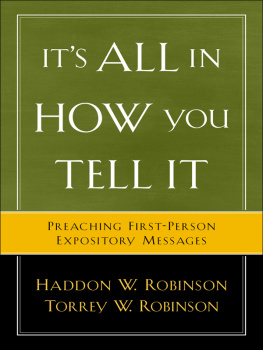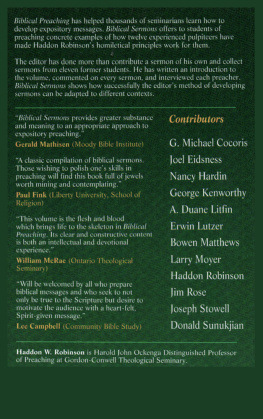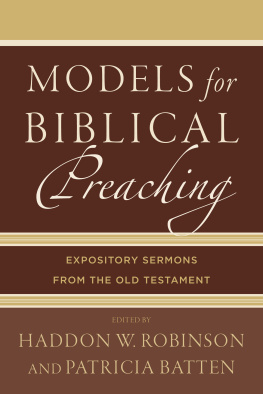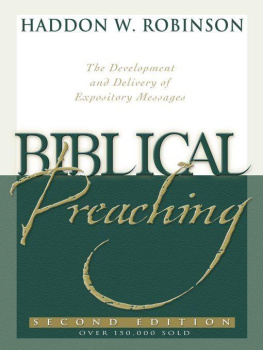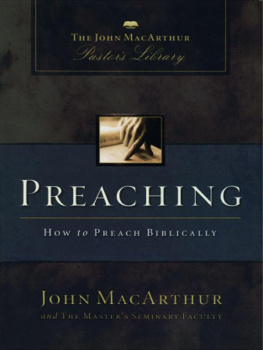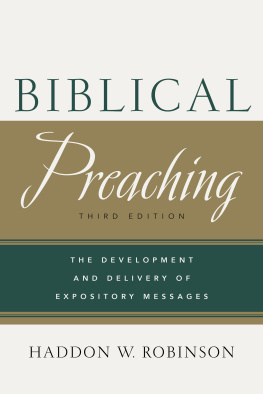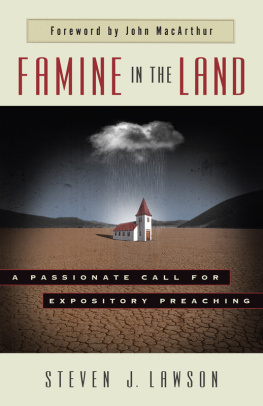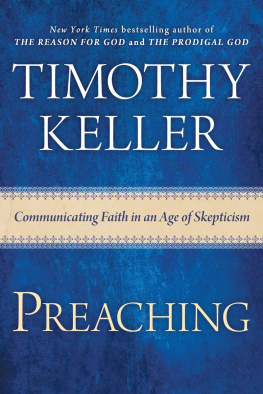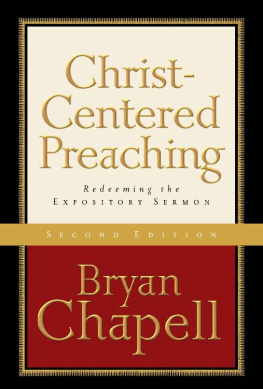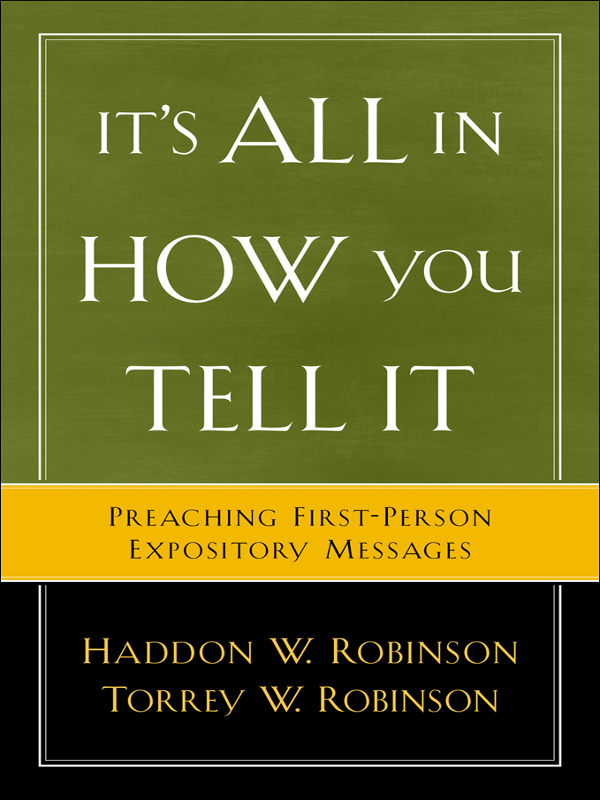
Its All in
How You Tell It
Preaching First-Person Expository Messages
Haddon W. Robinson
Torrey W. Robinson

2003 by Haddon W. Robinson and Torrey W. Robinson
Published by Baker Books
a division of Baker Publishing Group
P.O. Box 6287, Grand Rapids, MI 49516-6287
www.bakerbooks.com
E-book edition created 2011
All rights reserved. No part of this publication may be reproduced, stored in a retrieval system, or transmitted in any form or by any meansfor example, electronic, photocopy, recordingwithout the prior written permission of the publisher. The only exception is brief quotations in printed reviews.
ISBN 978-1-5855-8464-2
Library of Congress Cataloging-in-Publication Data is on file at the Library of Congress, Washington, D.C.
Unless otherwise indicated Scripture is taken from the Holy Bible, New International Version. NIV. Copyright 1973, 1978, 1984 by Biblica, Inc. Used by permission of Zondervan. All rights reserved worldwide. www.zondervan.com
Scripture marked NASB is taken from the New American Standard Bible , Copyright 1960, 1962, 1963, 1968, 1971, 1972, 1973, 1975, 1977, 1995 by The Lockman Foundation. Used by permission. www.lockman.org
To Carey and Carl:
Almost a hundred and fifty years ago, in Northern Ireland, your great-great-grandfather staggered home drunk past a church where they were singing an old hymn:
There is life for a look at the crucified one.
There is life at this moment for thee.
Look sinner look unto him and be saved,
Unto him who died on the tree.
Look, look, look and live
To him who died on the tree.
Hearing the words of that hymn, your great-great-grandpa surrendered his life to Christ and became a lay preacher. All his children became Christians. By Gods grace, that story, that faith was passed on to your great-grandfather, to your grandfather, and then to your father. Now that story has become your story.
It is our prayer that your children and your grandchildren may know the truth of that story as they see it lived out in you.
Contents
Witnesses to the power of first-person preaching
What is an expository first-person sermon? What makesfirst-person sermons effective?
How do I determine a text to preach? And how do I exegetethat text for a first-person sermon?
How do I determine which character to portray and how toportray the character?
How do I structure the sermon? Where do my exegeticaland historical details fit into the sermon?
What about staging and delivery?
How do I deal with the unique challenges of first-personpreaching?
by Steve Mathewson
by Kent Edwards
by Sid Buzzel
by Haddon Robinson
by Alice Mathews
by Torrey Robinson
by Torrey Robinson
The following terms are important to the discussion of first-person preaching and will be employed in this book:
Anachronisms: Jargon or references that are out of their proper historical time. For example, Joseph wore sandals, not shoes. He was a slave, not an employee, in Potiphars house.
Blocking: Assigning a location on the stage to the character or characters in each scene.
Characterization: The way the author or narrator describes, contrasts, parallels, and depicts the words and actions of the characters in the narrative.
Chronological Development: A story constructed chronologically, that is, one event following another as it happened in time.
Deduction: Reasoning from the general to the specific. Most sermons of the last fifty years in the Western world have tended to follow a deductive pattern. They usually start with a summary point and move from this general assertion to the specific details or subpoints of the sermon.
Dramatic Monologue: A sermon preached from the viewpoint of an eyewitness to an event.
Exposition: Preaching which confronts the hearers with an accurate interpretation of the biblical revelation and its present meaning for their lives. []
First-Person Sermon: (same as dramatic monologue)
First-Person Expository Sermon: An expository sermon preached from a first-person perspective. In other words, this preaching form is based on an accurate interpretation of the Scripture and applies its meaning to the hearers. It does this through the retelling of the scriptural account from the vantage point of a character who was part of the story.
Flashback: An interruption in the continuity of a story that relays an earlier episode.
Genre: In reference to literature, it is the specific type or classification of the literary work such as prose, poetry, or narrative.
Hermeneutically Inconsequential: In a few biblical texts (such as the parables of Jesus), the historicity and identity of the characters are not essential to the interpretation and preaching of the narrative.
Hermeneutically Indispensable: In most narrative biblical texts, the historicity and identity of the character or characters were assumed by the biblical writer and are essential to the interpretation and preaching of the narrative.
Historical Narrative: A nonfiction story.
Homiletics: The preparation and delivery of sermons.
Induction: Reasoning from the specific to the general. Stories are inductive, moving from specific actions and events to a general moral or lesson.
Narrative: A story, either fiction or nonfiction.
Narrative Literature: The literary genre also known as story.
Psychological Development: A narrative constructed or relayed by a thought sequence rather than chronologically. The unfolding of the story is not based on a steady progression in time. Instead, the story develops logically or according to another expected flow of thought.
Stance: In first-person preaching, stance describes the perspective of the character in relation to the twenty-first-century audience. For example, does the character know the audience? Is the character familiar with his or her culture? Is the audience listening to the character on the ancient scene, or is the character imaginatively transported into the twenty-first century?
Third-Person Narrative: A story communicated by a narrator who is not part of the story being told. For example, in his Gospel, Luke gives a third-person narrative account of the life of Jesus.
The pastor slumped down in his seat opposite me in the restaurant and played with his water glass. Then he made a comment that sounded like a confession: I am bored, very bored, with my own preaching. He was an effective leader of the largest church in a half-gallon town in the Midwest. He administered a staff of seven that oversaw a variety of ministries within the congregation and the community. But when it came to preaching, he gave himself low marks. He summed up his pulpit work in the words of a member of his church who described his sermons as a tad or two above average.
What surprised me, though, was how he put it. He wasnt saying, I am afraid that I am boring my congregation. He was admitting something even more deadening: I am boring myself with my own preaching.
He wasnt talking about the grinding regularity of producing a new sermon each week. He carved out at least twelve hours a week from his demanding schedule for sermon preparation, and he enjoyed working in the biblical text. He studied, and he had something important to say. He wasnt bored with the Bible; he was bored with himself. His problem wasnt content; it was creativity. No matter where he was in the Scriptures, no matter what genre of literature he was preaching, one size fit all. He was sick of it.
Next page
